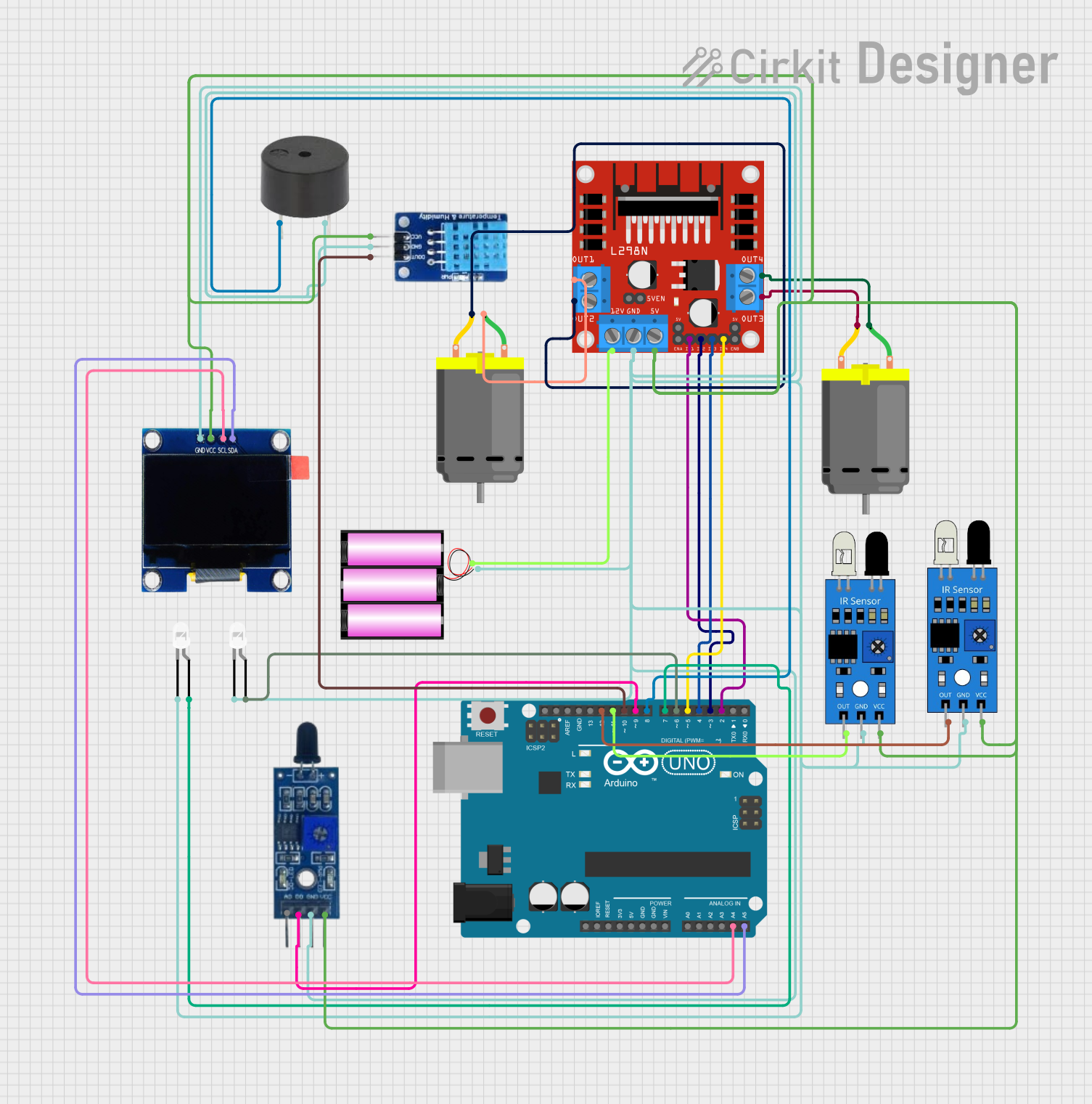
Arduino UNO Controlled Environment Monitoring System with Motorized Alert Mechanism

Circuit Documentation
Summary
This circuit is designed to interface an Arduino UNO with various sensors, actuators, and an OLED display. The primary components include an Arduino UNO microcontroller, an L298N DC motor driver, two DC motors, a buzzer, two white LEDs, a flame sensor, a DHT11 temperature and humidity sensor, an OLED display, two IR sensors, and a 12V battery. The circuit is capable of reading sensor data, displaying information on the OLED, controlling the buzzer and LEDs based on sensor inputs, and driving the motors.
Component List
Arduino UNO
- Microcontroller board based on the ATmega328P
- It has 14 digital input/output pins, 6 analog inputs, a 16 MHz quartz crystal, a USB connection, a power jack, an ICSP header, and a reset button.
L298N DC Motor Driver
- A motor driver module capable of driving two DC motors or one stepper motor.
- It has 2 H-bridges and can handle a current up to 2A per channel.
DC Motor (x2)
- Electric motors that convert DC electrical energy into mechanical energy.
Buzzer
- An electronic buzzer that produces sound when provided with an electrical signal.
LED: Two Pin (white) (x2)
- Standard white LEDs with an anode and cathode for emitting light when a current passes through them.
Flame Sensor
- A sensor that can detect the presence of a flame or fire.
DHT11
- A basic, ultra-low-cost digital temperature and humidity sensor.
OLED 1.3"
- A small OLED display for showing text, graphics, and images.
Battery 12V
- A 12V battery that provides power to the circuit.
IR Sensor (x2)
- Infrared sensors used for object detection or distance measurement.
Wiring Details
Arduino UNO
A4connected to OLED SCLA5connected to OLED SDAD12connected to IR Sensor 2 OUTD11connected to IR Sensor 1 OUTD10connected to DHT11 DATAD9connected to Flame Sensor D0D8connected to Buzzer PIND7connected to LED 1 AnodeD6connected to LED 2 AnodeD5connected to L298N IN4D4connected to L298N IN3D3connected to L298N IN2D2connected to L298N IN1
L298N DC Motor Driver
IN1toIN4connected to corresponding Arduino UNO pinsOUT1andOUT2connected to DC Motor 1OUT3andOUT4connected to DC Motor 212Vconnected to Battery 12V +GNDconnected to common ground5Vconnected to common 5V
DC Motor 1
pin 1connected to L298N OUT1pin 2connected to L298N OUT2
DC Motor 2
pin 1connected to L298N OUT4pin 2connected to L298N OUT3
Buzzer
PINconnected to Arduino UNO D8GNDconnected to common ground
LED 1
anodeconnected to Arduino UNO D7cathodeconnected to common ground
LED 2
anodeconnected to Arduino UNO D6cathodeconnected to common ground
Flame Sensor
VCCconnected to common 5VGNDconnected to common groundD0connected to Arduino UNO D9
DHT11
DATAconnected to Arduino UNO D10GNDconnected to common groundVCCconnected to common 5V
OLED 1.3"
GNDconnected to common groundVCCconnected to common 5VSCLconnected to Arduino UNO A4SDAconnected to Arduino UNO A5
Battery 12V
+connected to L298N 12V-connected to common ground
IR Sensor 1
outconnected to Arduino UNO D11gndconnected to common groundvccconnected to common 5V
IR Sensor 2
outconnected to Arduino UNO D12gndconnected to common groundvccconnected to common 5V
Documented Code
#include <Wire.h>
#include <Adafruit_GFX.h>
#include <Adafruit_SSD1306.h>
// OLED display settings
#define SCREEN_WIDTH 128
#define SCREEN_HEIGHT 64
#define OLED_RESET -1
Adafruit_SSD1306 display(SCREEN_WIDTH, SCREEN_HEIGHT, &Wire, OLED_RESET);
// DHT11 settings
#define DHTPIN 10
#define DHTTYPE DHT11
DHT dht(DHTPIN, DHTTYPE);
// Flame sensor pin
#define FLAME_SENSOR_PIN 9
// Buzzer pin
#define BUZZER_PIN 8
// LED pins
#define LED1_PIN 7
#define LED2_PIN 6
// L298N motor driver pins
#define IN1_PIN 2
#define IN2_PIN 3
#define IN3_PIN 4
#define IN4_PIN 5
// IR sensor pins
#define IR_SENSOR1_PIN 11
#define IR_SENSOR2_PIN 12
void setup() {
// Initialize serial communication
Serial.begin(9600);
// Initialize OLED display
if (!display.begin(SSD1306_I2C_ADDRESS, OLED_RESET)) {
Serial.println(F("SSD1306 allocation failed"));
for (;;);
}
display.display();
delay(2000);
display.clearDisplay();
// Initialize DHT11 sensor
dht.begin();
// Initialize flame sensor pin
pinMode(FLAME_SENSOR_PIN, INPUT);
// Initialize buzzer pin
pinMode(BUZZER_PIN, OUTPUT);
// Initialize LED pins
pinMode(LED1_PIN, OUTPUT);
pinMode(LED2_PIN, OUTPUT);
// Initialize motor driver pins
pinMode(IN1_PIN, OUTPUT);
pinMode(IN2_PIN, OUTPUT);
pinMode(IN3_PIN, OUTPUT);
pinMode(IN4_PIN, OUTPUT);
// Initialize IR sensor pins
pinMode(IR_SENSOR1_PIN, INPUT);
pinMode(IR_SENSOR2_PIN, INPUT);
}
void loop() {
// Read DHT11 sensor data
float humidity = dht.readHumidity();
float temperature = dht.readTemperature();
// Read flame sensor data
int flameSensorValue = digitalRead(FLAME_SENSOR_PIN);
// Read IR sensor data
int irSensor1Value = digitalRead(IR_SENSOR1_PIN);
int irSensor2Value = digitalRead(IR_SENSOR2_PIN);
// Display data on OLED
display.clearDisplay();
display.setTextSize(1);
display.setTextColor(SSD1306_WHITE);
display.setCursor(0, 0);
display.print("Temp: ");
display.print(temperature);
display.print(" C");
display.setCursor(0, 10);
display.print("Humidity: ");
display.print(humidity);
display.print(" %");
display.setCursor(0, 20);
display.print("Flame: ");
display.print(flameSensorValue ? "No" : "Yes");
display.setCursor(0, 30);
display.print("IR1: ");
display.print(irSensor1Value ? "No" : "Yes");
display.setCursor(0, 40);
display.print("IR2: ");
display.print(irSensor2Value ? "No" : "Yes");
display.display();
// Control buzzer based on flame sensor
if (flameSensorValue == LOW) {
digitalWrite(BUZZER_PIN, HIGH);
} else {
digitalWrite(BUZZER_PIN, LOW);
}
// Control LEDs based on IR sensors
digitalWrite(LED1_PIN, irSensor1Value == LOW ? HIGH : LOW);
digitalWrite(LED2_PIN, irSensor2Value == LOW ? HIGH : LOW);
// Control motors (example: forward motion)
digitalWrite(IN1_PIN, HIGH);
digitalWrite(IN2_PIN, LOW);
digitalWrite(IN3_PIN, HIGH);
digitalWrite(IN4_PIN, LOW);
delay(1000);
}
This code initializes the components and reads data from the sensors. It displays the sensor data on the OLED screen, controls the buzzer based on the flame sensor, and controls the LEDs based on the IR sensors. The motors are set to move forward as an example. You can modify the motor control logic as needed for your application.
How to Upload Code
To upload the code to your Arduino UNO, follow these steps:
Install the Arduino IDE:
- If you haven't already, download and install the Arduino IDE from the official Arduino website.
Connect the Arduino UNO: